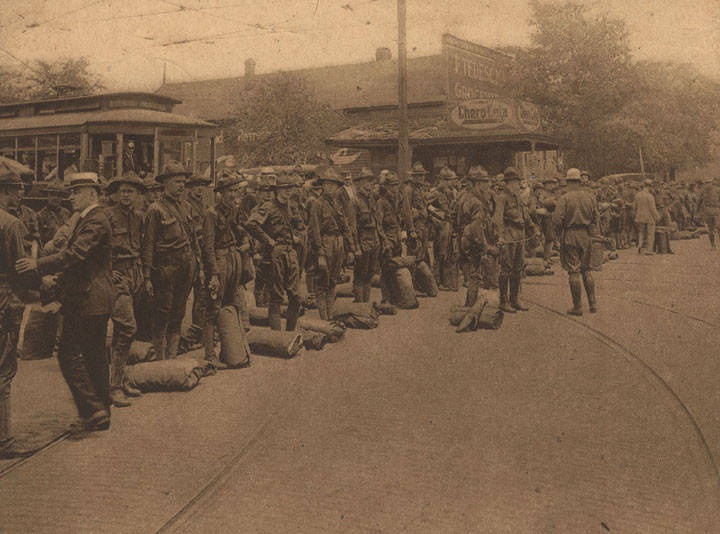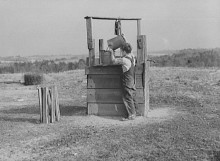Mexican Revolution
In 1910, a revolution in Mexico began. All across Mexico, volunteers aligned with different factions, and Pancho Villa aligned with Francisco I. He soon became one of the best and certainly the most famous Mexican Revolutionary generals.
 Pancho Villa (Bain Publishing Library of Congress)
Pancho Villa (Bain Publishing Library of Congress)
Villa and his supporters seized hacienda land for distribution to peasants and soldiers. He robbed and commandeered trains and, like the other revolutionary generals, printed fiat money to pay for his cause.
Attack on Columbus, New Mexico
“In the early morning darkness of March 9, 1916, guerrillas of the Mexican Revolution under General Francisco “Pancho” Villa attacked Columbus, New Mexico a small border town and military camp on what is now Pancho Villa State Park.
At sunrise on the morning of March 9, 1916, the center of Columbus, New Mexico was a smoldering fire. Words of Pancho Villa’s attack on the town were known by telegraph, making newspaper headlines throughout the nation. U.S. reacted with troops that arrived by train as the Army prepared to follow Villa into Mexico.”
 Ruins of Columbus (National Park Service)
Ruins of Columbus (National Park Service)
Trouble started in 1915
Trouble between the United States and Pancho Villa started in the summer of 1915 when Villa made an assault on the forces of Carranza. Villa suffered a loss of around 14,000 men. On October 21, 1915, President Woodrow Wilson officially recognized the faction of Venustiano Carranza as being the legitimate government of Mexico. Villa felt betrayed by the United States.
In January 1916, two officers under Villa’s command, attacked a train that included a group of 18 Americans, fifteen of who worked for American Smelting and Refining Company. Most of the Americans were shot were they sat. Only one American managed to survive and tell the story of the massacre.
Birmingham Citizen Soldiery Leave for the Mexican Frontier. In solemn lines thousands bade the boys Godspeed. From the rotogravure section of the Birmingham-Age-Herald, Sunday, July 30, 1916 – photographer Birmingham View Company Q9639
President Wilson ordered a punitive raid
In response to the raid on Columbus, New Mexico on March 9, 1916, President Wilson ordered a punitive raid into Mexico with the goal of capturing Pancho Villa.
 Birmingham Citizen Soldiery Leave for the Mexican Frontier Battery C awaiting orders to march. July 30, 1916 From the rotogravure section of the Birmingham-Age-Herald, Sunday, July 30, 1916 – photographer Birmingham View Company Q9641
Birmingham Citizen Soldiery Leave for the Mexican Frontier Battery C awaiting orders to march. July 30, 1916 From the rotogravure section of the Birmingham-Age-Herald, Sunday, July 30, 1916 – photographer Birmingham View Company Q9641
 Birmingham Citizen Soldiery Leave for the Mexican Frontier Battery C awaiting orders to march. July 30, 1916 From the rotogravure section of the Birmingham-Age-Herald, Sunday, July 30, 1916 – photographer Birmingham View Company Q9641
Birmingham Citizen Soldiery Leave for the Mexican Frontier Battery C awaiting orders to march. July 30, 1916 From the rotogravure section of the Birmingham-Age-Herald, Sunday, July 30, 1916 – photographer Birmingham View Company Q9641
Wire sent to Governor Henderson of Alabama
On June 18, 1916, Secretary of War Newton D. Baker wired Governor Henderson of Alabama as follows:
“Having in view the possibility of further aggression upon the territory of the United States from Mexico and the necessity for the proper protection of that frontier, the President has thought proper to exercise the authority vested in him by the Constitution and Laws and call out the Organized Militia and the National Guard necessary for that purpose. I am in consequence instructed by the President to call into the service of the United States forthwith through you the following units of the Organized Militia and the National Guard of the State of Alabama which the President directs shall be assembled at the State Mobilization Camp at Montgomery for muster into the Service of the United States of America:
- One Brigade of three Regiments of Infantry,
- Two Batteries of Field Artillery,
- One Signal Corps Company.”
This telegram has been designated as the President’s Call.
Alabama troops organized in Montgomery
The necessary mobilization of troops at Vandiver Park in Montgomery began in the latter part of June, 1916, or immediately subsequent to the President’s Call. On July 1, 1916, the Adjutant General of Alabama wired the War Department that all organizations of the Alabama National Guard had been called into the Service of the United States.
Mobilization of the Alabama National Guard for service on the Mexican border was announced. It included five regiments, the largest being the 4th Alabama,that had been created as militia by the Alabama legislature in 1911.
 Birmingham Citizen Soldiery Leave for the Mexican Frontier. Battery C, Mrs. Lewis Underwood and Oscar Underwood, Jr. From the rotogravure section of the Birmingham-Age-Herald, Sunday, July 30, 1916 – photographer Birmingham View Company Q9642
Birmingham Citizen Soldiery Leave for the Mexican Frontier. Battery C, Mrs. Lewis Underwood and Oscar Underwood, Jr. From the rotogravure section of the Birmingham-Age-Herald, Sunday, July 30, 1916 – photographer Birmingham View Company Q9642
In 1916, U.S. Army General John J. Pershing tried unsuccessfully to capture Villa in a nine-month pursuit that ended when the United States entered into World War I and Pershing was called back.






My Grandfather was one of those men.
” Only the dead have heard the last of war”- Plato
Great stories about the history of ALABAMA……….
So does this mean Alabama is the volunteer state
I did not know this about our history. Thanks for posting.
My grandfather got into a fight with a boy at school in Cottondale, AL. This boy later joined the military unit that went after Pancho Villa and was killed in battle. Never did find out what the boy’s name was.
Love this Charlie gonna borrow and post if u don’t mind….
Anthony Cooper
my grandfather ,Lonnie L.Hughes was one of those soldiers also.While in Mexico ,he saw his 1st airplane.By the time WWI started ,he had finagled way out of the AL. infantry and into the regular army air corps.
My great uncle, Fred A. Griffin, from Cottondale was killed on March 9, 1916 when guerrillas under Pancho Villa attacked at Columbus, New Mexico. He was doing sentry duty in front of the home of his captain. He was 18 years old.
May have ben in 1915 instead of 1916
Thank you for your reply. All the newspaper articles I have read say that he was killed on March 9, 1916 and his tombstone says March 9, 1916. What is your source for 1915?
My grandfather. Angus M. Shirah, Sr. drove the sidecar Harley Davidson for General Pershing in this war.